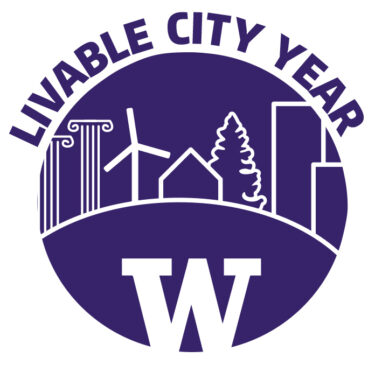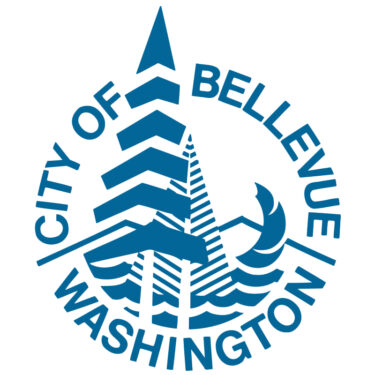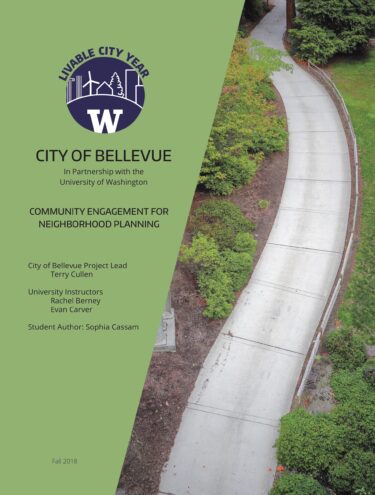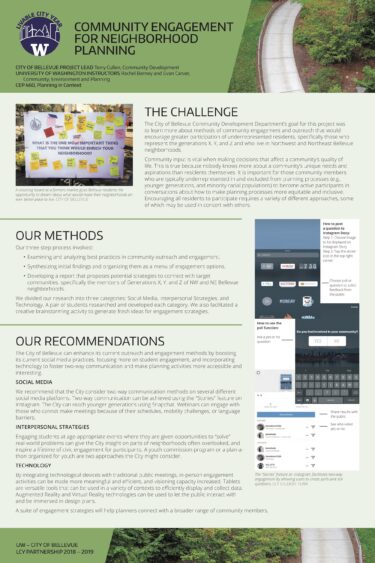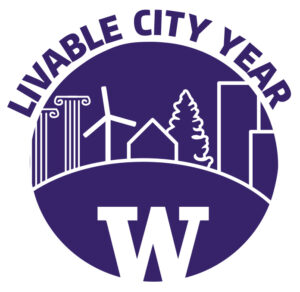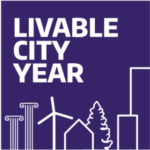Community Engagement for Neighborhood Planning
2018-2019 Livable City Year – Bellevue
City Project Leads: Terry Cullen, Community Development
UW Instructor: Rachel Berney and Evan Carver, Community, Environment and Planning
Course: CEP 460, Planning in Context
Project summary:
This Neighborhood Planning report provides community outreach and engagement recommendations to the City of Bellevue. The Department of Community Development in Bellevue seeks to develop and apply more inclusive neighborhood planning practices in order to expand its reach across a broader range of communities. The City asked six students completing the Community, Environment, and Planning (CEP) undergraduate major at the University of Washington (UW), to research and develop engagement strategies for the City to reach Generations X,Y, and Z, which include individuals born between 1965-1980, 1981-1996, and 1997-2012, respectively. The recommendations of this report are based on case studies from various cities, literature reviews, individual research on new technology, and a creativity session carried out by our team.
Some forms of outreach and engagement work better for different populations. Platforms, like public meetings and forums, for sharing information and engaging with community members about planning processes, as well as documents produced to inform community members about future projects and events, should be accessible to everyone. We have identified several different recommendations to help accommodate and reach the diverse populations represented by Generations X, Y, and Z. The central findings of this report are broken down into four categories: Social Media, Interpersonal, Technology, and Creativity Session. Within each category, we offer a set of recommendations for the City to consider. Many of these recommendations build upon what has already been done before by the City of Bellevue; some incorporate ideas that have been used elsewhere; and others are new to the field of planning.
Each section includes relevant findings from our research that helped us develop the list of recommendations. Included within each section is a matrix that helps identify which recommendation is best suited for a desired outcome, such as broadcasting information to the public or facilitating community discussions. The last section of this report is titled “Implementation.” In this section, we analyze recommendations and o er suggestions for pairing certain recommendations.
Five key findings
- Tailoring engagement strategies to suit communities is an imperative step toward planning for healthy, thriving neighborhoods.
- The City of Bellevue can expand its use of social media to not only broadcast information, but also to engage community members in conversation and data collection.
- Integrating technological devices can make in-person engagement activities more efficient and meaningful, and it can increase visioning capacities.
- Engaging students at age-appropriate programs where they have opportunities to “solve” real-world problems is one way the City can learn from youth perspectives; this may also inspire a lifetime of civic engagement for youth and young adult community members.
- The City of Bellevue can use these recommendations to create a suite of engagement strategies that will allow planners to hear from a broader range of community members and yield greater results from their engagement efforts.
Part of the 2018-2019 Livable City Year partnership between the University of Washington and the City of Bellevue.
See all Livable City Year projects in Bellevue that UW students and faculty worked on during the year-long partnership.
